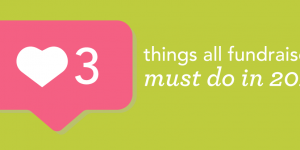So you just finished your special event. You raised a lot of money and you also made a lot of new friends. What happens next will determine whether or not your new and existing donors remain engaged. Isn’t that always the predicament? For many organizations, it seems as though they’re always asking. Well, any good fundraiser will tell you that raising money is a year-round thing. Aside from developing programming that furthers your organization’s mission, you’re responsible for making sure you have the resources necessary to do so. Now, “resources” is a broad term that can mean money, manpower, or valuable community partnerships. Regardless of what it is you need, you’ve got to ask and ask well.
Last month I attended an excellent workshop hosted by the New York City chapter of the Association of Fundraising Professionals (AFP) entitled Become An Ask Master: Hone Your Approach and Learn from the Pros. Though the focus was largely on major donor cultivation and in-person asking, there were some pretty undeniable takeaways that can be applied to asking in appeal form.
I was so inspired after I left the workshop that I decided to share some of what I learned with our readers. So this month I’ll be breaking out four things you need to know before you ask, starting with knowing the basics. We talk a lot about crafting a plan before starting any communications effort, so getting a lot of this behind-the-scenes maintenance out of the way will help you transition from special events right into a spring campaign that allows you to cultivate your newfound audience.
Know Your Story.
This might seem simple, but really narrowing down what your organization’s story is can be hard work. The best advice we can give to get you going is to start with why. Most appeal letters I receive talk a lot about what these organizations do. There’s a lot of boring rhetoric about programs and outcomes, and a lot of that just doesn’t resonate. Drill this information down and communicate about why you do what you do and therein lies your story.
When crafting an appeal or meeting with a prospective funder, you’ve got to know your organization. Go beyond populations served and hours spend on specific projects and talk about your values and what drives your organization’s board, staff, and volunteers to stay involved. Know your history, know your accomplishments, and know your needs. Forging that deeper connection with the person on the other end is half the battle.
Know Your Goals.
Don’t ever go into an ask without knowing what you want from the person receiving it. Laying the foundation for the ask is hard work, so the last thing you want to do is trip when you’re about the cross the finish line. If you’re looking to raise money, start by identifying a dollar amount that you’d like to reach and then make specific asks based on giving history. You could also do what organizations like the Wikimedia Foundation do and ask modestly. You know those types of appeals: If everyone seeing this message right now gave $5 our fundraiser would be over in 10 minutes. Not everyone has the global audience that Wikipedia does, but if you’ve got a large number of donors, give it a shot. Plus, this makes for an excellent email or social media campaign. Higher education institutions are especially good at this when it comes to appealing to young alumni. The key here is volume.
For face to face interactions, typically with major donors, it’s important to lay out your goal from the outset. A major donor’s time is valuable, so make sure you get to the point right up front that way your remaining time is spent telling your story and establishing whether or not this partnership is a good fit for both parties involved. Whether you’re asking in person or in the form of a letter, if the person you’re talking to doesn’t know what you want it’s hard for them to follow through. Create a clear pathway to giving and engagement.
Know the Ways to Give.
There’s nothing worse than an appeal email riddled with tons of links and multiple calls to action. The copy might be incredibly engaging, but an overload of actions and places to click can create donor confusion. If you’re going to be clear about who you are and what you want, you need to make it easy for people to follow through. What’s just as important as keeping your call to action clear is providing enough information about how gifts can be made. Online? By check? Over the phone? Know how you can accept donations and be ready to do so.
A few things to remember:
- For online gifts, make sure your donation page is mobile friendly.
- For checks, make sure your address is clearly marked. Better yet, provide a return envelope.
- Have a follow up procedure in place so that thank you’s can be made promptly after a gift’s received.
Know what needs improving.
If you’ve using the same mail or email templates for a few years and response rates seem to be slowly in decline, your communications could just need a simple makeover. Spring is a great time to test out things that are fresh and new. Play around with fonts and colors to make your calls to action stand out, or consider trying out a different format all together. Sometimes donors just need to see that you’re investing in yourself before they feel compelled to invest in you. Small tweaks can go a long way to making things more attractive and exciting. Getting people revved up about what you do and what you’re about is one just step when it comes to keeping you on the tops of their minds.
The Wrap Up
A good foundation is the start to a great fundraising campaign. Before you begin any fundraising effort, return to the drawing board and cover these four steps. As the giving landscape changes, it’s crucial that organizations remain agile and relevant. We’ll continue this journey to making a stronger ask next week by covering personal approaches that focus on building relationships and not just building revenues. Everything this month is leading up to a very special conclusion where we interview Laura Fredricks, Expert on the Ask.
Like what you see? Stay in touch!
You Might Also Enjoy:
+ How to Make Your End of Year Emails Go the Extra Mile
+ Race to the Finish: New Year, New Look
+ Why Donor-Centered Campaigns Get Results












